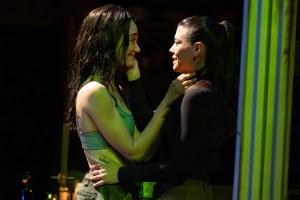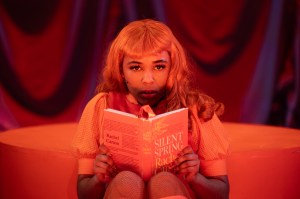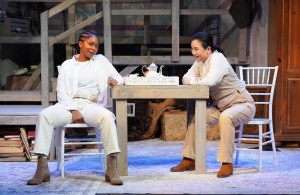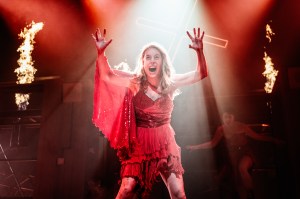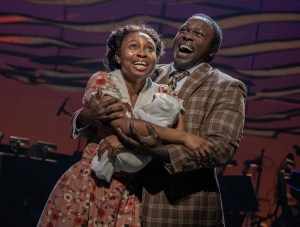
in When We Dead Awaken
(Photo: Ron Williams)
Lights flicker, illuminating a pale figure dressed in white followed by another ominous figure clad in black. Thunder rolls and the stage is once more plunged into darkness. It’s an arresting opening image for Henrik Ibsen’s When We Dead Awaken, the final installment in the Century Center’s ambitious five-year series devoted to the father of modern drama. Starting with Ibsen’s 1877 work, Pillars of Society, the series mounted full productions of the 12 major prose plays by the Norwegian dramatist in the chronological order in which he wrote them. Ibsen’s last play, written in 1899, is rarely performed, so it is a unique opportunity to see it here, directed by the Century Center’s artistic director, J.C. Compton.
Ably assisted by her designers, Compton has opted for an atmospheric, dream-like production. Graham Kindred deserves special mention for a lighting design that perfectly captures the mood of each of the three major sections of the performance. Nicholas Wentworth’s storm-heavy sound design is also noteworthy, as are the elegant period costumes supplied by Pam Snyder.
The play poses numerous challenges as it totters between domestic drama and expressionistic symbolism. It begins with a married couple, Arnold Rubek (Dennis Parlato) and his wife, Maja (Tami Dixon); Rubek is a famous sculptor and it soon becomes obvious that there is a vast emotional chasm between himself and his much younger spouse. She soon becomes fascinated by a rugged bear-killer named Ulfhejm (Carl Palmer) while her husband reunites with his former model and muse, Irene (Elisabeth S. Rodgers). A pale reflection of her former self, Irene is constantly trailed by a dark figure (played by Tom Knutson). In Ibsen’s original script, this figure was a nun; it’s unclear why the gender of the character has been altered for this production, but Knutson displays a large wooden cross, indicating he is supposed to be some kind of monk or priest.
The actors seem most comfortable in the play’s more naturalistic moments. The beginning of Act II features a scene between Rubek and Maja, as they attempt to renegotiate the state of their marriage. Dixon displays a quiet restraint, indicating her character’s emotional suffering through small movements of her head and body. Unfortunately, as the play descends more and more into the symbolic, the credibility of the actors becomes strained: They verge on the melodramatic or speak in cryptic tones that do not seem to have any specific intention behind the words.
Overall, the Century Center’s production of When We Dead Awaken comes across as curiously dispassionate. The focus here is more on mood rather than the characters’ emotional lives. This allows Compton to experiment with the script’s symbolic excesses but, ultimately, it does a disservice to a complex and difficult play.




